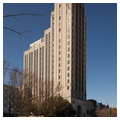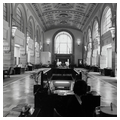You are here
Central Fidelity Bank (Central National Bank)
Broad Street merchants created the Central National Bank to serve the retail district. The Broad Street financial concern specifically conceived of the Art Deco tower as a challenge to the skyscraper monopoly of the Main Street financial district. This building and the Medical College of Virginia West Hospital (RI19) are the only stepped-back skyscrapers in the city. The building is one of the great twentieth-century landmarks of Virginia architecture. The exterior is composed in two parts with a tower toward Broad Street (which recalls Eliel Saarinen's entry in the Chicago Tribune competition of 1922) and a shorter tail to the rear. The large vaulted banking lobby is a lavish Art Deco exercise in nearly pristine condition.
Writing Credits
If SAH Archipedia has been useful to you, please consider supporting it.
SAH Archipedia tells the story of the United States through its buildings, landscapes, and cities. This freely available resource empowers the public with authoritative knowledge that deepens their understanding and appreciation of the built environment. But the Society of Architectural Historians, which created SAH Archipedia with University of Virginia Press, needs your support to maintain the high-caliber research, writing, photography, cartography, editing, design, and programming that make SAH Archipedia a trusted online resource available to all who value the history of place, heritage tourism, and learning.






